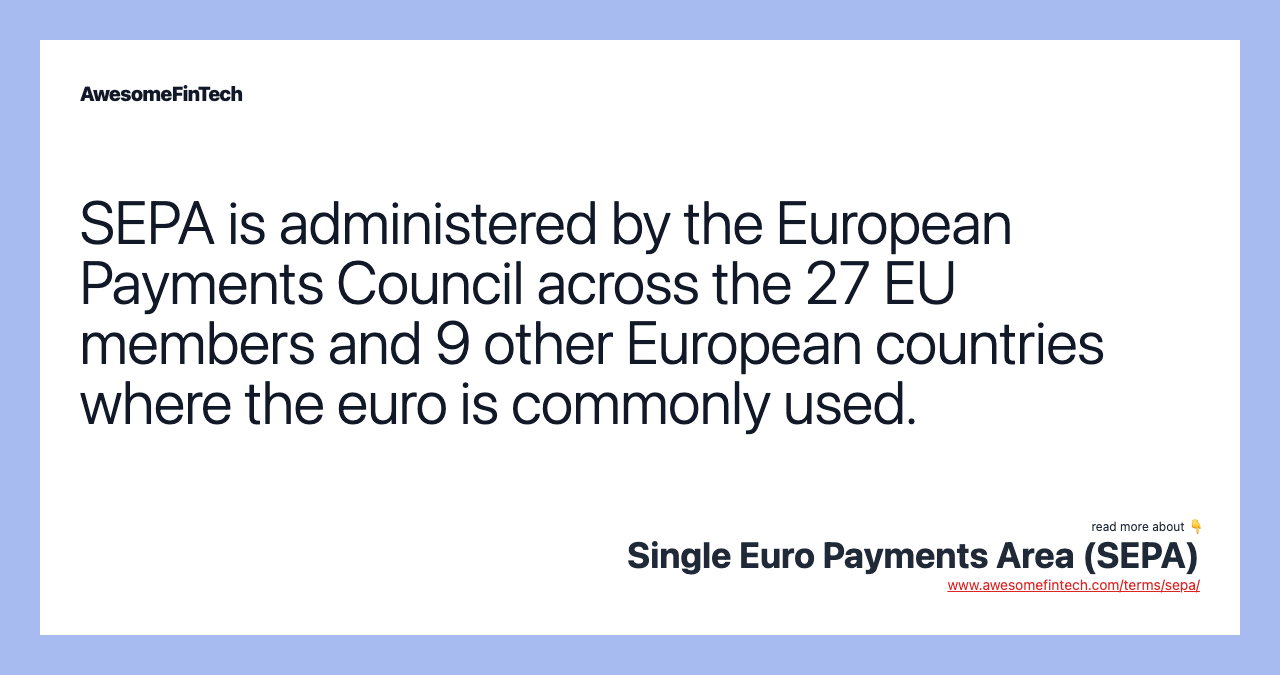Single Euro Payments Area (SEPA)
The single euro payments area (SEPA) is a system of transactions created by the European Union (EU). SEPA consists of four payment processing schemes: 1. The SEPA Credit Transfer Scheme 2. The SEPA Instant Credit Transfer Scheme 3. The SEPA Direct Credit Core Scheme 4. The SEPA Direct Debit Business-to-Business Scheme These schemes set the rules and implementation guidelines for how member nations regulate electronic euro payment processing amongst themselves. SEPA is a regulatory initiative to facilitate cross-border cashless payments in euro-using countries by harmonizing payment processing across euro-using countries. SEPA is managed by the European Payments Council on a collaborative basis with the European Commission, the European Central Bank (ECB), and other European stakeholder groups. SEPA makes it possible for retail transactions to directly debit accounts in another member country and for those living, working, or traveling to use accounts in their home country to receive direct deposit payments and pay bills by electronic transfer.

More in Economy
What Is a Single Euro Payments Area (SEPA)?
The single euro payments area (SEPA) is a system of transactions created by the European Union (EU). The SEPA harmonizes the way cashless payments are transacted between euro countries. European consumers, businesses, and government agents who make payments by direct debit, instant card transfer, and credit transfers use the SEPA architecture. The SEPA makes it possible for people doing business in these countries to make cashless payments across borders with the same cost and convenience of domestic payments. The single euro payment area is approved and regulated by the European Payment Council (EPC).



Understanding SEPA
The purpose of the SEPA initiative is to make cross-border electronic payments as inexpensive and easy as payments within one country. SEPA makes it possible for retail transactions to directly debit accounts in another member country and for those living, working, or traveling to use accounts in their home country to receive direct deposit payments and pay bills by electronic transfer. This helps promote labor mobility and economic integration among SEPA member countries. Also, the system brings more competition to the payments industry by creating a single market for payment services, thus bringing down prices.
SEPA consists of four payment processing schemes:
- The SEPA Credit Transfer Scheme
- The SEPA Instant Credit Transfer Scheme
- The SEPA Direct Credit Core Scheme
- The SEPA Direct Debit Business-to-Business Scheme
These schemes set the rules and implementation guidelines for how member nations regulate electronic euro payment processing amongst themselves.
SEPA currently facilitates over 43 billion transactions per year in 36 member countries. It encompasses the 27 EU member states along with the U.K., Iceland, Norway, Liechtenstein, Switzerland, Andorra, Vatican City, Monaco, and San Marino. The single euro payment area remains an ongoing, collaborative initiative among these parties. SEPA is in the process of harmonizing rules regarding mobile and online payments.
SEPA is managed by the European Payments Council on a collaborative basis with the European Commission, the European Central Bank (ECB), and other European stakeholder groups.
History of the Single Euro Payments Area
In 2007, the European Union passed the Payment Services Directive. The Directive formed the legal basis for the establishment of the SEPA in 2008. By 2014, SEPA was fully implemented for credit and debit payments.
On December 15, 2019, the European Commission extended rules forbidding banks to charge extra cross-border transaction fees to non-euro EU member countries as well. The new regulation dictates that all people in the EU have the right to transfer euros across borders at the same cost as they would pay for a domestic transaction. The new rules also require that consumers are informed of the cost of a currency conversion before they make a payment abroad in a currency different than their home currency.
Related terms:
Antitrust
Antitrust laws apply to virtually all industries and to every level of business, including manufacturing, transportation, distribution, and marketing. read more
Digital Currency
Digital currency are digital formats of currencies that do not exist in physical form. They can lower transaction processing costs and enable seamless transfer across borders. read more
Euro Notes
Euro notes are the euro-denominated banknotes issued by the ECB that make up the currency of the eurozone. read more
European Customs Union
The European Union Customs Union ensures the tariff-free movement of goods within the EU and standard customs duties on goods imported by the EU. read more
European Central Bank (ECB)
The European Central Bank (ECB) is the consolidated central bank of the EU, coordinating the regions monetary policy efforts. read more
European Union (EU)
The European Union (EU) is a group of countries that acts as one economic unit in the world economy. Its official currency is the euro. read more
MiFID II
MiFID II is a European Union packet of financial industry reform legislation, instituted to regulate financial markets that replace MiFID. read more
Monetary Union Index of Consumer Prices (MUICP)
The Monetary Union Index of Consumer Prices (MUICP) is an aggregate measure of consumer inflation for all countries located in the Eurozone. read more
Passporting
Passporting allows a firm registered in the European Economic Area (EEA) to do business in any other EEA state without further authorization. read more